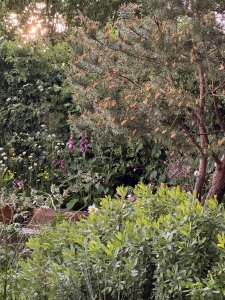The Weekly Mash Fri May 23
Hello folks. There’s a horticultural theme this week. As ever, thoughts are welcome. Tell your many friends.

Elvis Was Wrong
For years I have taken Elvis Costello’s words as an instruction. I too didn’t want to go to Chelsea, or specifically the Flower Show. Flowers? The assembled throng of the English middle class in chinos, blazers, and floral dresses? Not my scene.
One of my closest friends is a gardener. His hands are dirty, he lives his life in potting sheds, he prunes, digs, composts. It is hard, relentless work and he loves it, and I love what he has done, but the Show was too manicured, too… Society for me – he says, having never been.
I have a garden, and for years I half-heartedly planted it, though ’gardening’ seemed to be more about removal and destruction than growing and nurturing. A lightening of travel, lockdown and the recent brief incapacitation has resulted in a more considered approach to our patch of dirt.
My wife bought me a scythe for a significant birthday, probably as a comment of my advancing years, but I use it, sow seeds, plant, curse snails and slugs, encourage bees. It takes time, it takes patience as, like wine, you only get one chance a year.
So when an invitation came from Fielden to come along to Chelsea and see their collaboration with Kent Wildflower Seeds, I said yes immediately. It wasn’t just the promise of cocktails and Highballs that prompted the response. I had been wrong. I did want to go to Chelsea.
Ignoring the chinos, blazers, and floral dresses, I wandered through the show gardens. Rather than polite, manicured displays here was wildness at play. There was even a demon goat made of roses. A looseness to design, a celebration of what were once considered weeds. Gardens of tolerance to plant and climate.
There are parallels here with whisky. It came into being in its modern state as a result of the agricultural Improvements of the 18th century. The Enclosure Act of 1773 privatised the land, and in Scotland led to the Clearances and the end of the old, rural ways of whisky making.
Ever since, whisky distilling has been about man exerting greater control. An understanding of whisky from a biochemical angle, technological advances in equipment… and changes in the field with the introduction of ever higher-yielding barley strains requiring ever greater doses of chemicals.

Scale and efficiencies have led to a fracturing of the old relationships between field, farmer, maltster, and distiller. Of course good has come of this, but the balance has been lost. Whisky has ceased to be an agricultural product.
In a similar way, gardens moved from being the patch that provided food and a few cut flowers, to the primped and tweaked idea of what fashion dictated nature should look like – weedkiller blasted and free of tangle and sprawl.
Now, it would seem, the skill of the gardener lies in a willingness to let the wild in, allow it to play, and then gently work with it.
It was therefore appropriate that Fielden were at Chelsea. Farm-forward in its approach, its grains grown by the ‘maslin’ technique of sowing fields with a mix of seed (rye, wheat and barley), which are harvested together. The straw is chopped and then left in the field, sown with clover and the next year’s seeds.
It’s a medieval technique, the old ways revived – and it works. A major distiller should take a look (ah…)
Fielden is part of a web of distillers looking not at ‘process’, but at the field and the soil. ‘Regenerative thinking’ as Bruichladdich’s Allan Logan once told me. There’s farmer-distillers like Daftmill, Arbikie, Spirit of Yorkshire, Thy, Jeptha Cred, Frey Ranch, Auld, and soon Machrihanish – and many more re-establishing links with the farmers who grow their grain.
It is tied to the worldwide investigations into ‘lost’ varieties of barley, rye and corn, grown not just for flavour but to help reduce chemical inputs and help replenish the soil.
Surely there are opportunities for cross-collaborations here? How far could this go? Could a brand exist that isn’t tied to a single distillery, but an idea? Global whiskies with similar philosophies under the same label?
Distilling is about control, but it has to allow the wildness in to become compelling. Tend your garden.
———

Where Will The Diageo Chainsaw Hit?
Who’d be a multinational? Diageo breathed a sigh of relief when Trump decided to halt the proposed 25% tariffs he’d imposed on Canada and Mexico. Then he slapped 10% on the UK and EU.
The result is that the firm estimates that it could see profits fall by $150m per annum. Imagine what might happen if Trump reinstated the tariffs on Mexico and Canada, though that unlikely. I mean, what’s the chances of him making a precipitate decision?
Even this slight respite hasn’t halted the firm trying to win back City confidence by seeking ways to find $500m of cost savings.
If the retreat from DV was a matter of cutting low-hanging fruit, Diageo’s CFO Nik Jhangiani has his pruning shears fixed on bigger targets.
‘We see… some opportunities for what I would call substantial changes versus portfolio trimming,’ he said. ‘It’s clearly going to be above and beyond the usual smaller brand disposals you’ve seen over the last three years.’ This seems to avoid the question of who, at this time of low business confidence, would want to add larger brands to their portfolio?
If Jhangiani does lop off a few branches, which will he target? It is unlikely Diageo will pull out of India thanks to the trade deal [link], but could it shed Shuijingfan baijiu? Maybe some Scotch blends?
What about American whiskey? Bulleit’s warehouses are significantly overstocked (in common with many others in the States), which brings us back to the question of who would buy, but could the rest of Diageo’s US whiskey portfolio be under threat? What of Ireland? Questions, questions.
The DV-backed brands which escaped the cull must now be wondering whether how safe they are when the next round of cuts comes – as they will. You can rest assured that there’s a lot of folks not sleeping comfortably.
———-


In my (Kin) Glassie
Bid welcome my friends to the first releases of Inchdairnie’s single malts with the arrival of two 8-year-old expressions of its KinGlassie peated expression.
Raw (I’d have chosen another name, but hey-ho) is aged solely in ex-Bourbon, while Double Matured spent four years in ex-Bourbon, then three in amontillado casks. Both are bottled at 46.3%. Double Matured is around £79. Raw, an exclusive for The Whisky Exchange/Speciality Drinks, is the same price.
Raw is anything but, with only light and wholly integrated smoke that comes across with floral, heathery, sweet woodsmoke notes. A heady herbal element then emerges, a bouquet garni of rosemary, sage, Indian bay. There’s also some half-sooked Fox’s glacier mint.
The herbal elements are also there in the mouth alongside an almost creamy presence with only a few sparks of flame adding a necessary edge. The balance is spot-on: enough sweetness from the spirit, a gentle touch of oak-derived flavours, and that aromatic smoke. It dances. Water brings it into the moor – bog flowers, heather root and earth.
The palate fills out even more, adding an almost sake-like quality, then ripe pear Szechuan pepper and mint on the finish.
There’s a gentle, mossier, restraint to Double Matured. Green almond, floor polish and light citrus are there on the nose with only light smoke. Again, the balance is exemplary, the smoke adding accents throughout the palate. The amontillado cask’s presence is there, initially softening proceedings, then adding spikes of acidity. There’s hints of Basque cheesecake, lime and coffee.
Water ups the smoke. The almonds re-emerge, now roasted, along with a distinctly oxidative element. A toothsome pair.

It’s easy to look at Inchdairnie and see the triumph of science, engineering and technology and leap to the conclusion that all of this means it is solely about efficiencies, that the wild is not allowed through the door.
Then you step back and think of what all of the equipment is for. The mash filter was installed so that different grains (such as rye). There are two different types of stills to widen the flavour palette.
It makes a range for exchange, and a four-strong selection of single malt using wrt clarity, yeasts, distillation, cuts and casks to reflect the seasons. There’s KinGlassie and RyeLaw and annual experiments with mixed mashbills, oats, pot still. Everything you think a small ‘craft’ producer obsesses over is here.
Whisky isn’t binary. It’s not about small v large, or small = good, big = bad. It is about the thinking behind the whiskies, the growing of the crops. It is about mindset, and having vision, sensibility and courage.
———-

A-Musing
There’s a real skill in writing a press release, but at times you do wonder about some of the phrasing. The (ab)use of ‘unique’, ‘traditional oak’ etc. Even before you get to the body of the text you have to learn that the missive simply hasn’t been sent, but that its author is ‘reaching out’, a phrase which can only be uttered by The Four Tops.
Recently I was invited to a tasting which had been ‘thoughtfully curated’. Does this mean that the distiller’s other tastings are just chaotic messes? And can we just stop with the ‘curated’, please?
Then there was the whisky using casks that were toasted with with magma which we’re told was done with ‘volcanic precision’. Is there anything less precise than a volcano erupting? (Thanks to IR)
———-

In my ears
The Roches ‘Hammond Song’ on repeat daily. What a tune – crazy harmonies, Fripp’s guitar. Inspired. It makes me smile, it makes me cry.